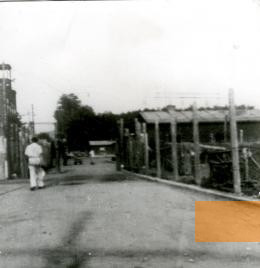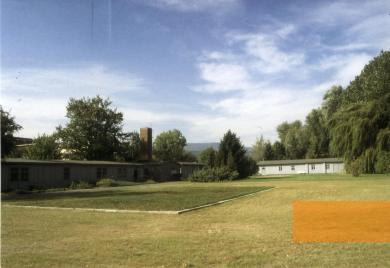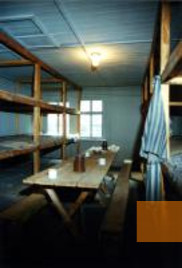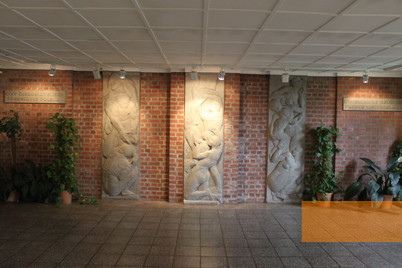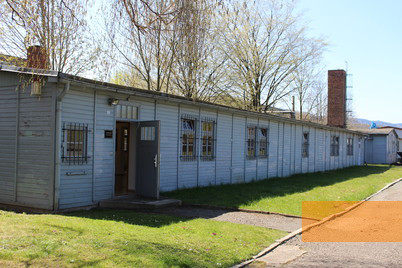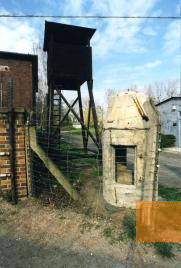In Wernigerode, a town located on the slopes of the Harz Mountains, a forced labour camp existed 1941 on. In 1943, it became a satellite camp of the Buchenwald concentration camp. The prisoners were deployed in production and tunnel building at the Rautal Works. Today, the Wernigerode Memorial honours their fates.
In 1941, a labour camp for 300 forced labourers from Flanders and Northern France was established at the Rautal Works in Wernigerode. The arms factory, considered by the SS crucial to war efforts, produced electric engines and engine parts. In the spring of 1943, the prisoners from the Buchenwald concentration camp began transforming the camp at Veckenstedter Weg into a satellite camp of Buchenwald. The SS codenamed the camp »Richard«. Seven barracks were erected, in which the SS accommodated hundreds of prisoners from Buchenwald. Occupancy reached its peak in 1944 when over 800 prisoners were held at the camp. They were deployed in production at the Rautal Works in the most primitive conditions. They also had to construct tunnels, as the factory management was planning to move production underground. Many forced labourers were so exhausted or sick after only three months of labour that they had to be brought back to the main camp and replaced by relatively healthy prisoners from Buchenwald. This turnover meant that there were constantly new prisoners coming to the Rautal Works.
In November 1944, forced labourers from camp »Richard« had to build a new satellite camp in nearby Hasserode. A new arms factory, the Wernig Works, responsible for the production of parts for the V-2 rocket, had been established here. After the »Steinerne Renne« (named after a waterfall in the area) camp had been completed, the Wernigerode satellite camp was dissolved at the end of December 1944 and all of the prisoners transferred to Hasserode.
In November 1944, forced labourers from camp »Richard« had to build a new satellite camp in nearby Hasserode. A new arms factory, the Wernig Works, responsible for the production of parts for the V-2 rocket, had been established here. After the »Steinerne Renne« (named after a waterfall in the area) camp had been completed, the Wernigerode satellite camp was dissolved at the end of December 1944 and all of the prisoners transferred to Hasserode.
The prisoners at the »Richard« satellite camp were mainly Poles, Russians, Czechs and South Slavs. They were subjected to horrific hygienic conditions and insufficient medical care at the camp. Heavy physical labour and frequent bouts of epidemics quickly exhausted the prisoners. It is estimated that 18 prisoners died in the Wernigerode satellite camp. Among them were seven prisoners who were hanged after attempting to escape. In April 1945, over 400 prisoners perished on a death march from the Hasserode satellite camp to the Leitmeritz concentration camp; many of them had previously been deployed at the »Richard« satellite camp.
In 1974, the former camp premises were remodelled to a memorial site on the initiative of former forced labourers and prisoners. In 1990, the memorial concept was redesigned. The new concept entailed involving the historic camp premises into the memorial more prominently, since the former prisoner barracks had for the most part remained intact. A new memorial and exhibition could be inaugurated in 1994 with the support of the Thuringian state government and the former Wernigerode administrative district. A memorial path was laid out on the former roll call grounds in honour of the forced labourers.
- Name
- Mahn- und Gedenkstätte Wernigerode
- Address
-
Veckenstedter Weg 43
38855 Wernigerode - Phone
- +49 (0) 3943 632 109
- Fax
- +49 (0) 3943 632 109
- Web
- http://www.kreis-hz.de/
- gedenkstaette.wernigerode@kreis-hz.de
- Open
- From April until October monday to friday 8 a.m. to 5 p.m
From November until March monday to friday 8 a.m. to 3 p.m.
Otherwise by appointment - Possibilities
- Permanent exhibition and special exhibitions, library and archive, guided tours, educational offers, seminars on various topics


